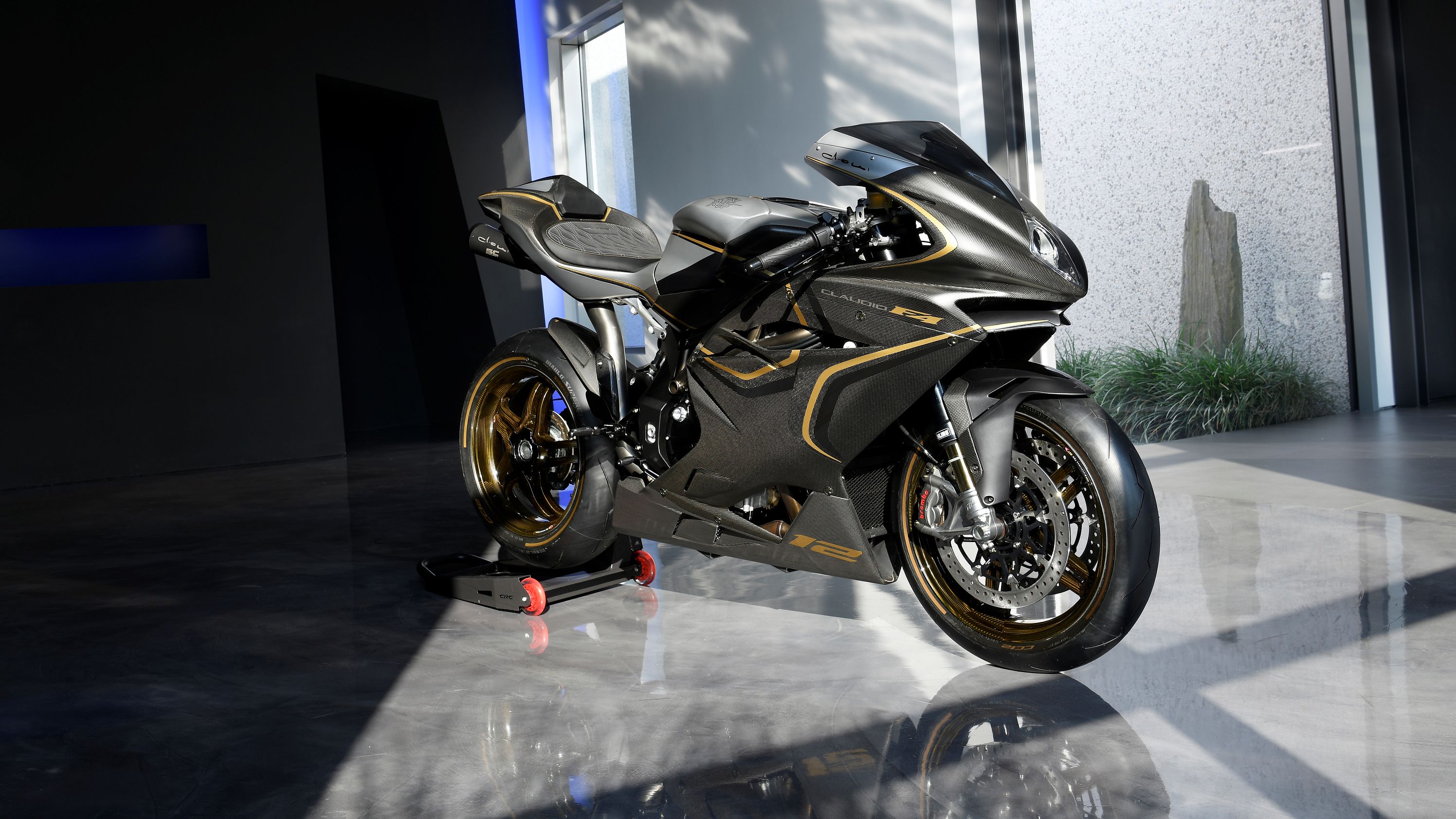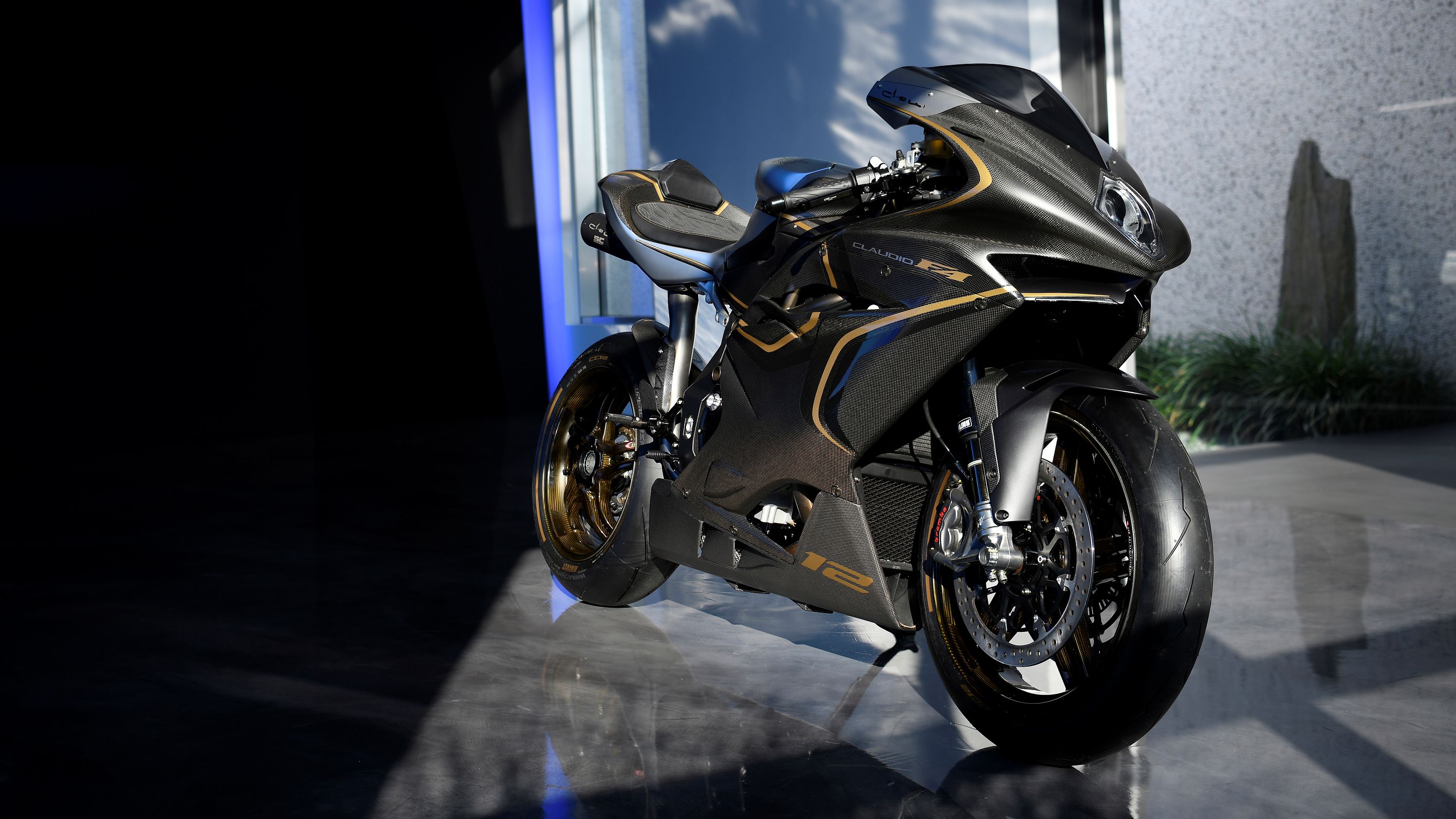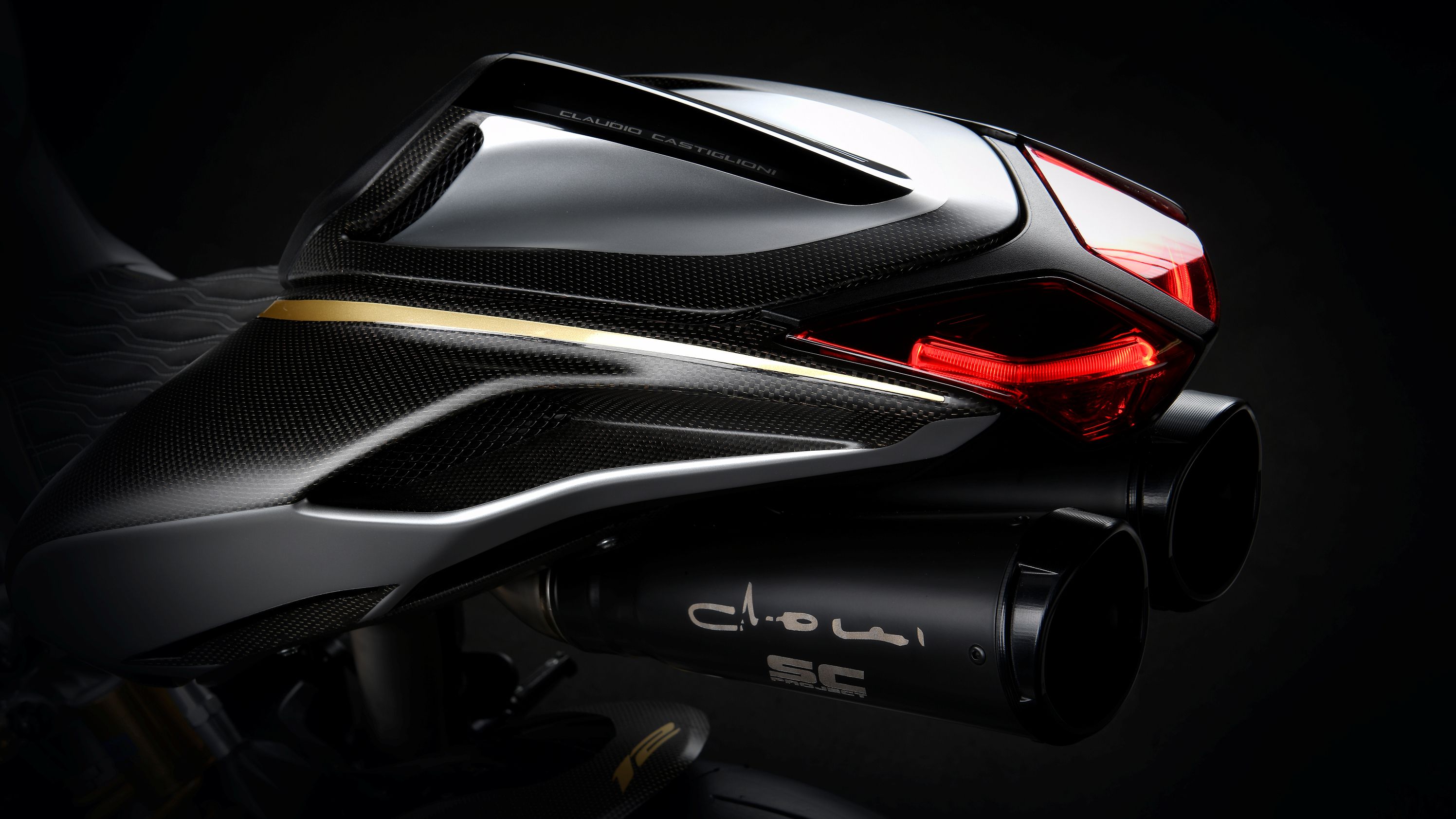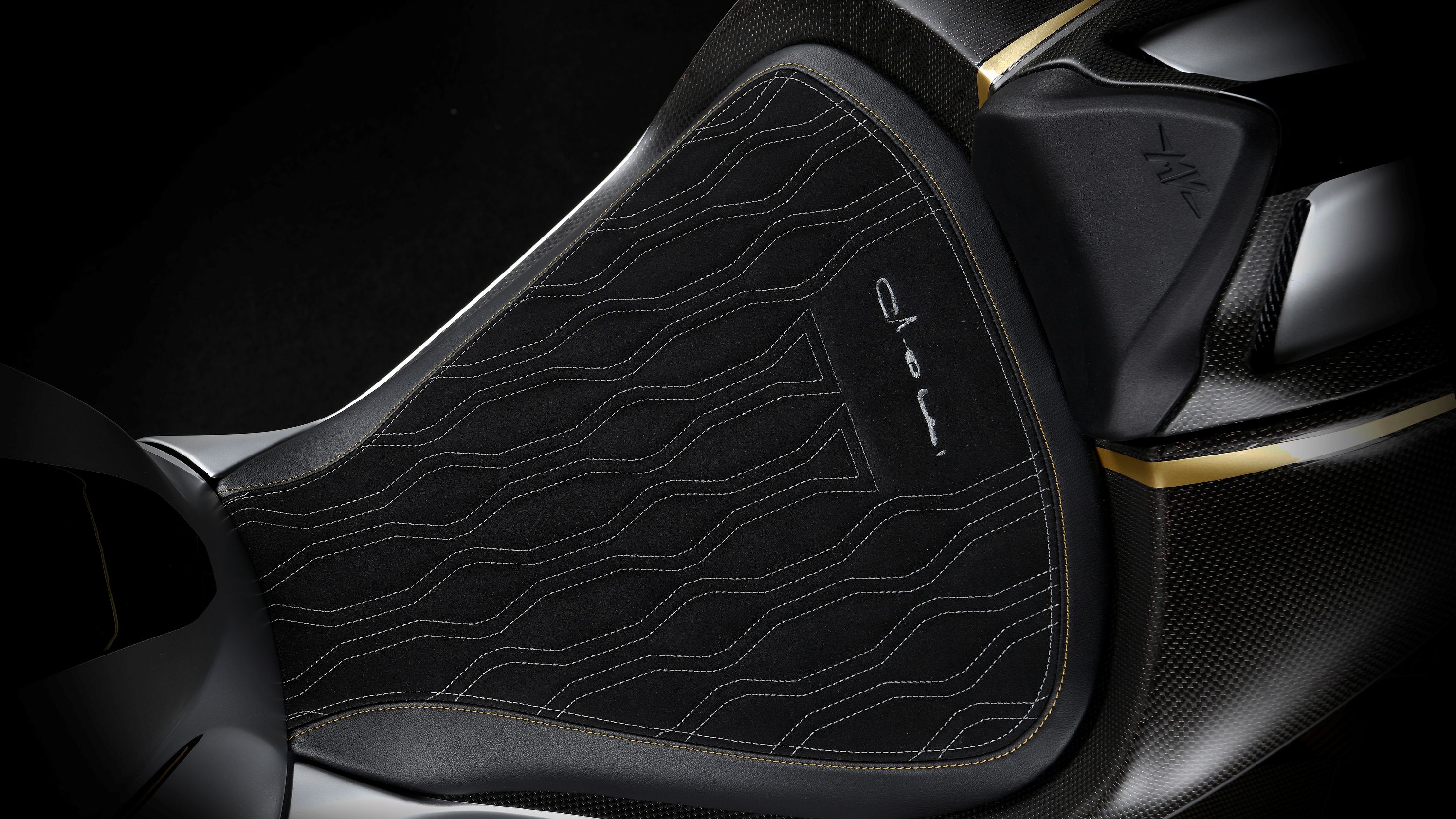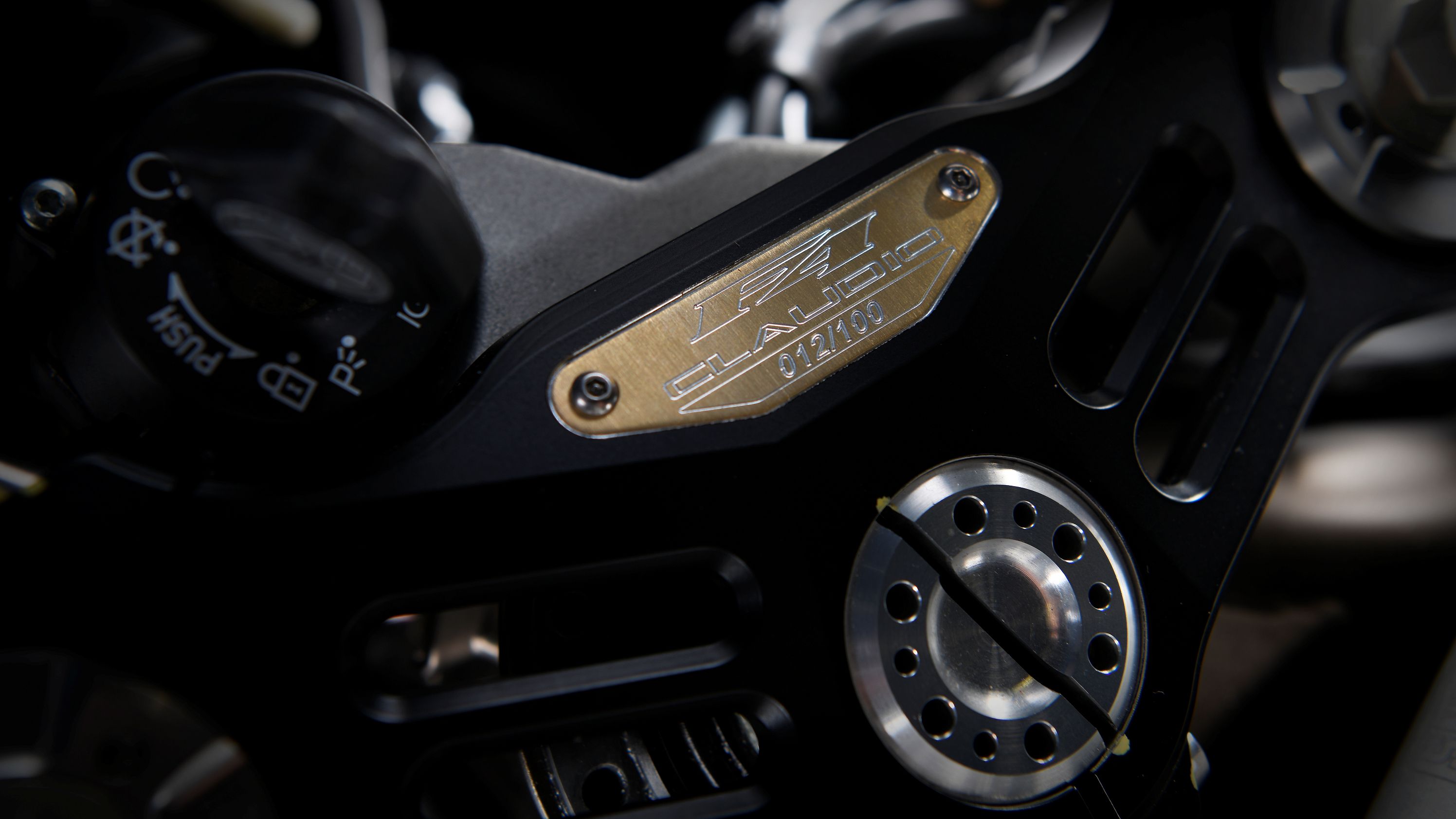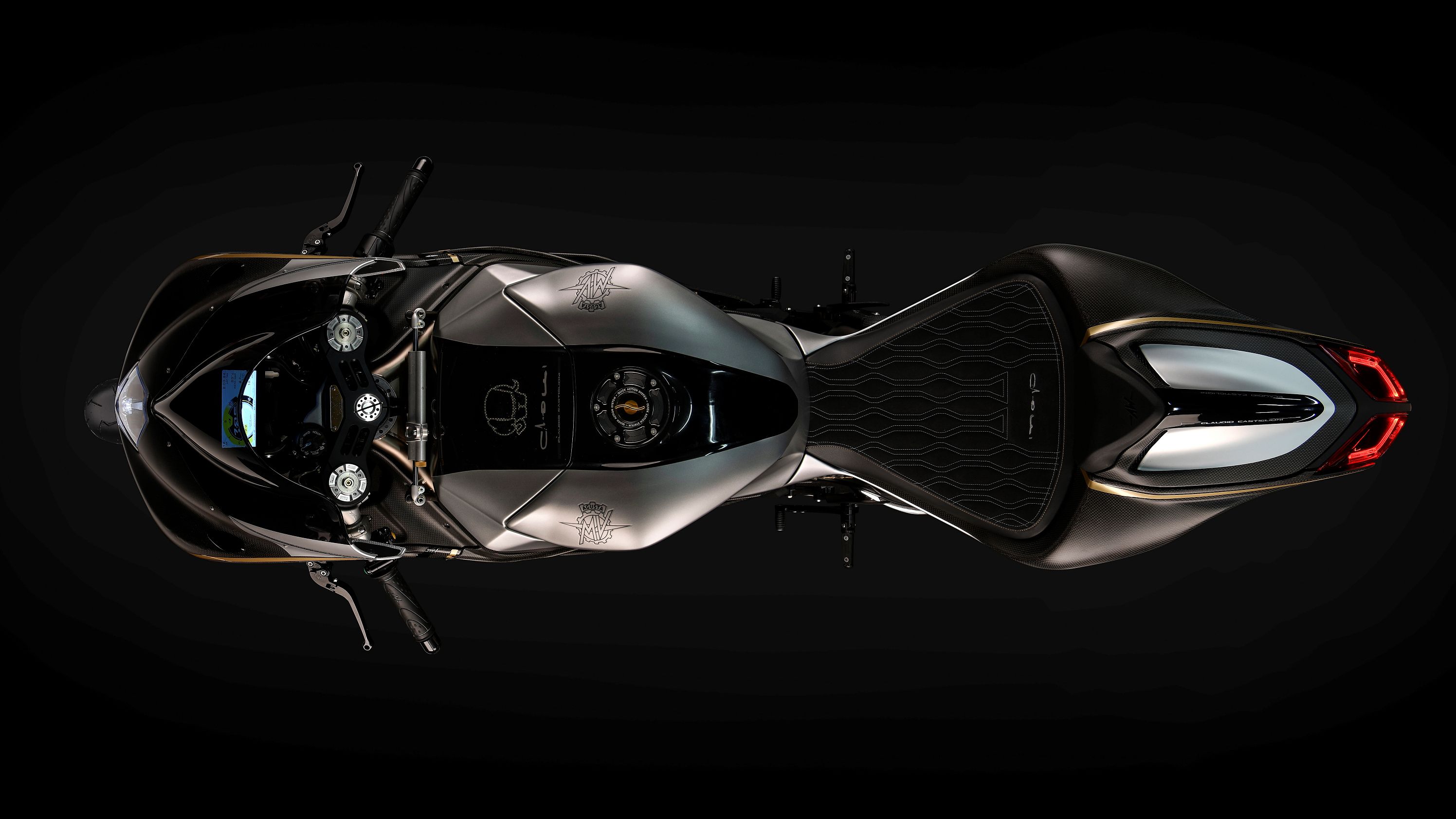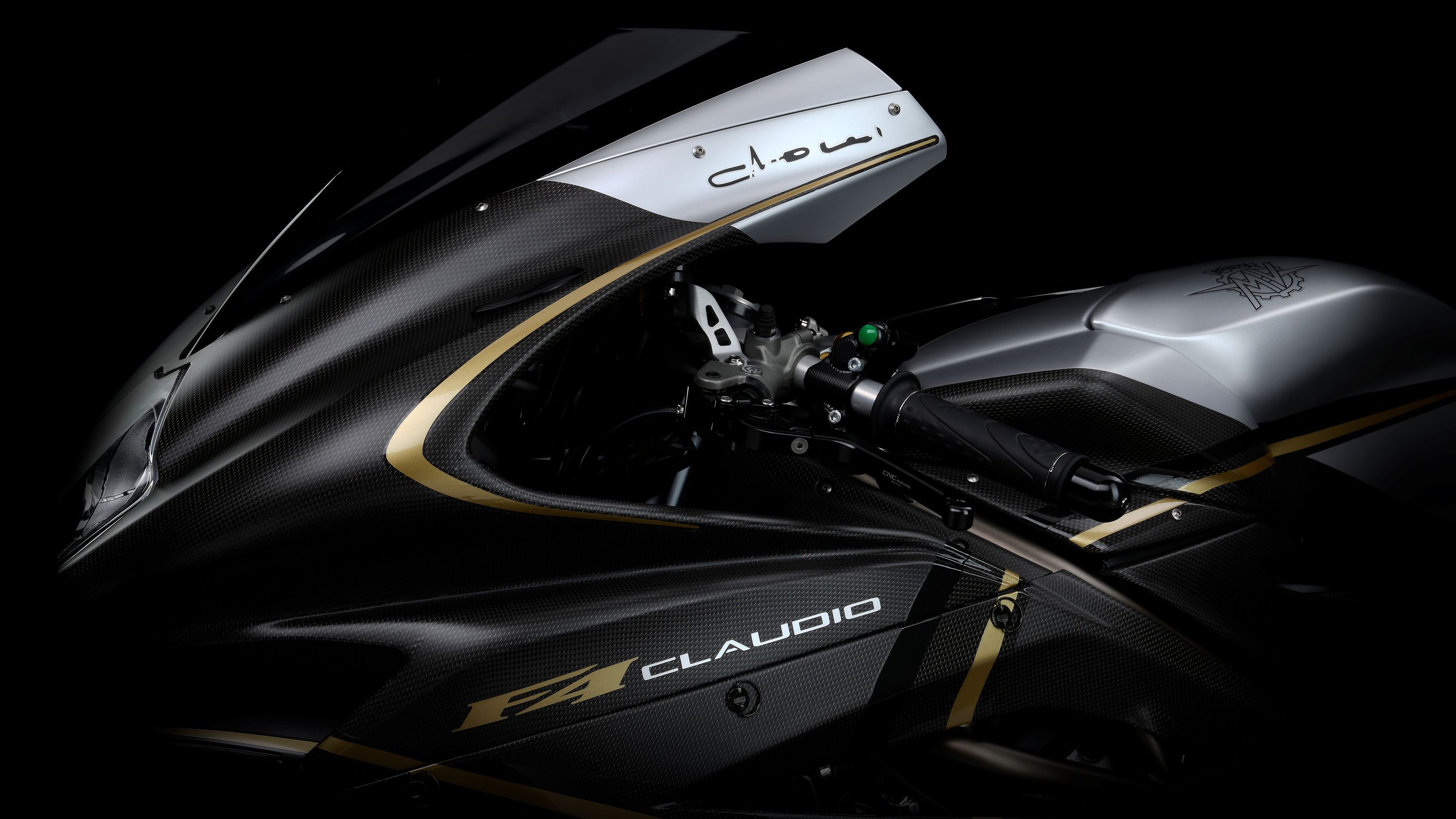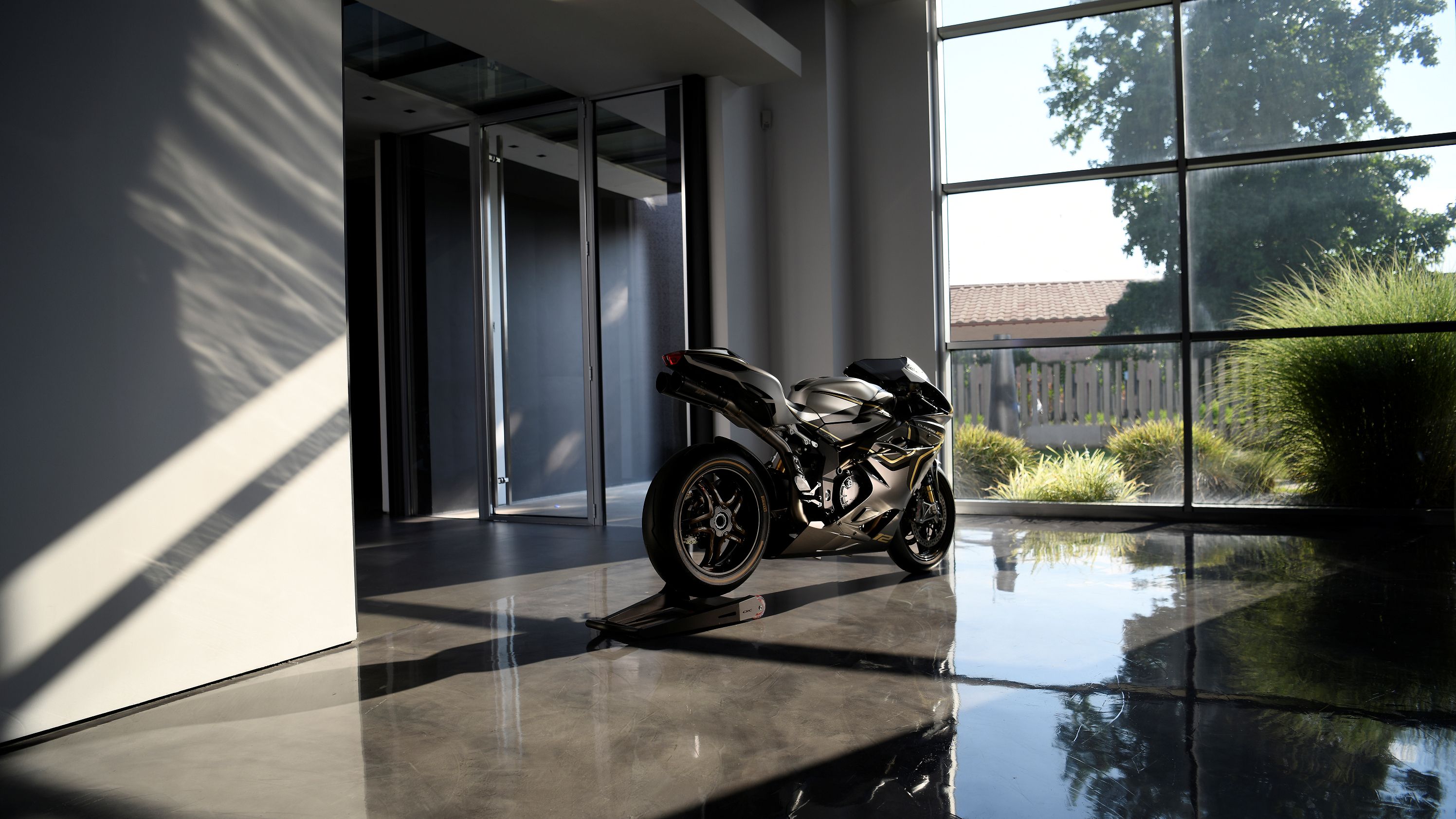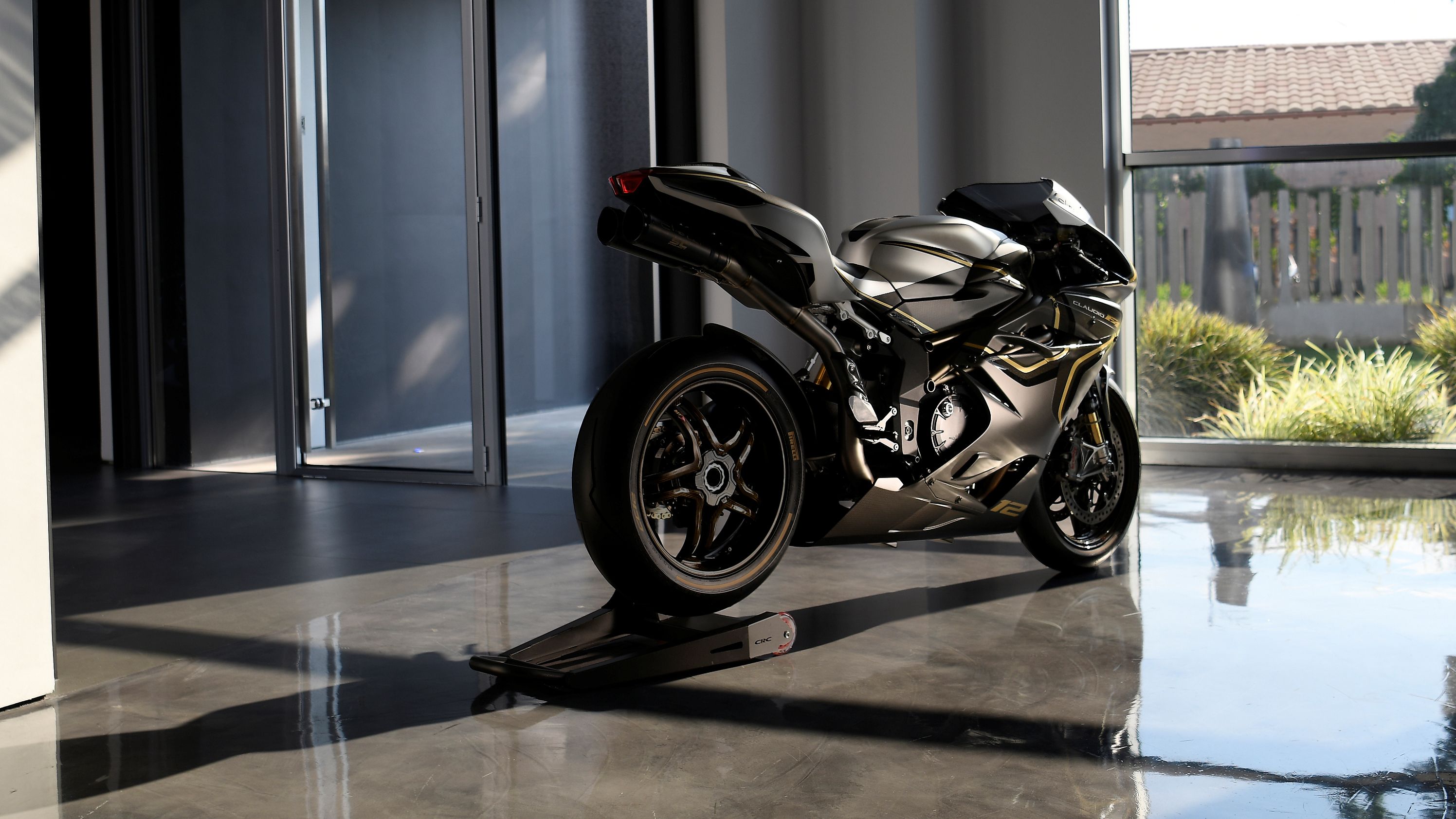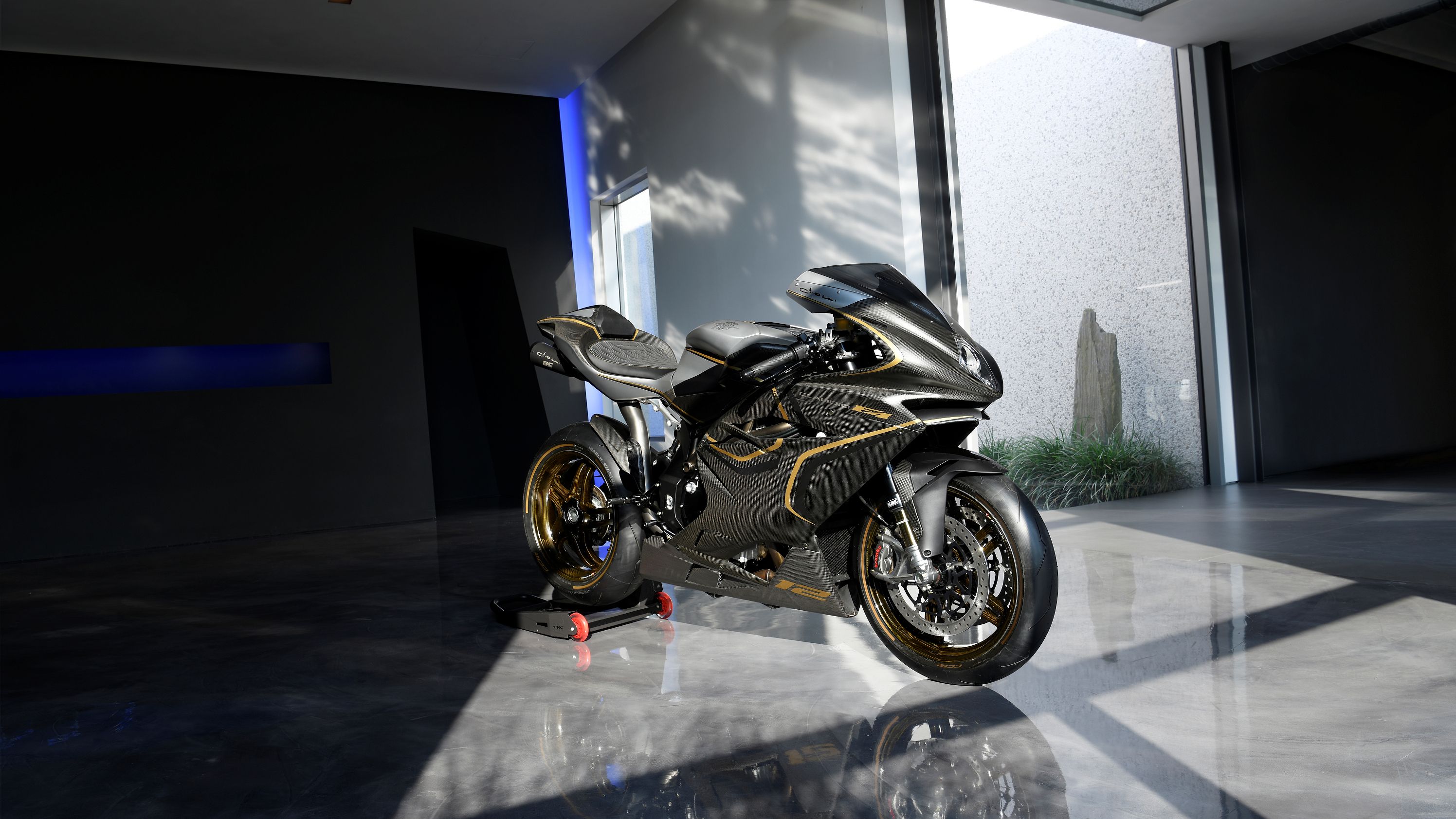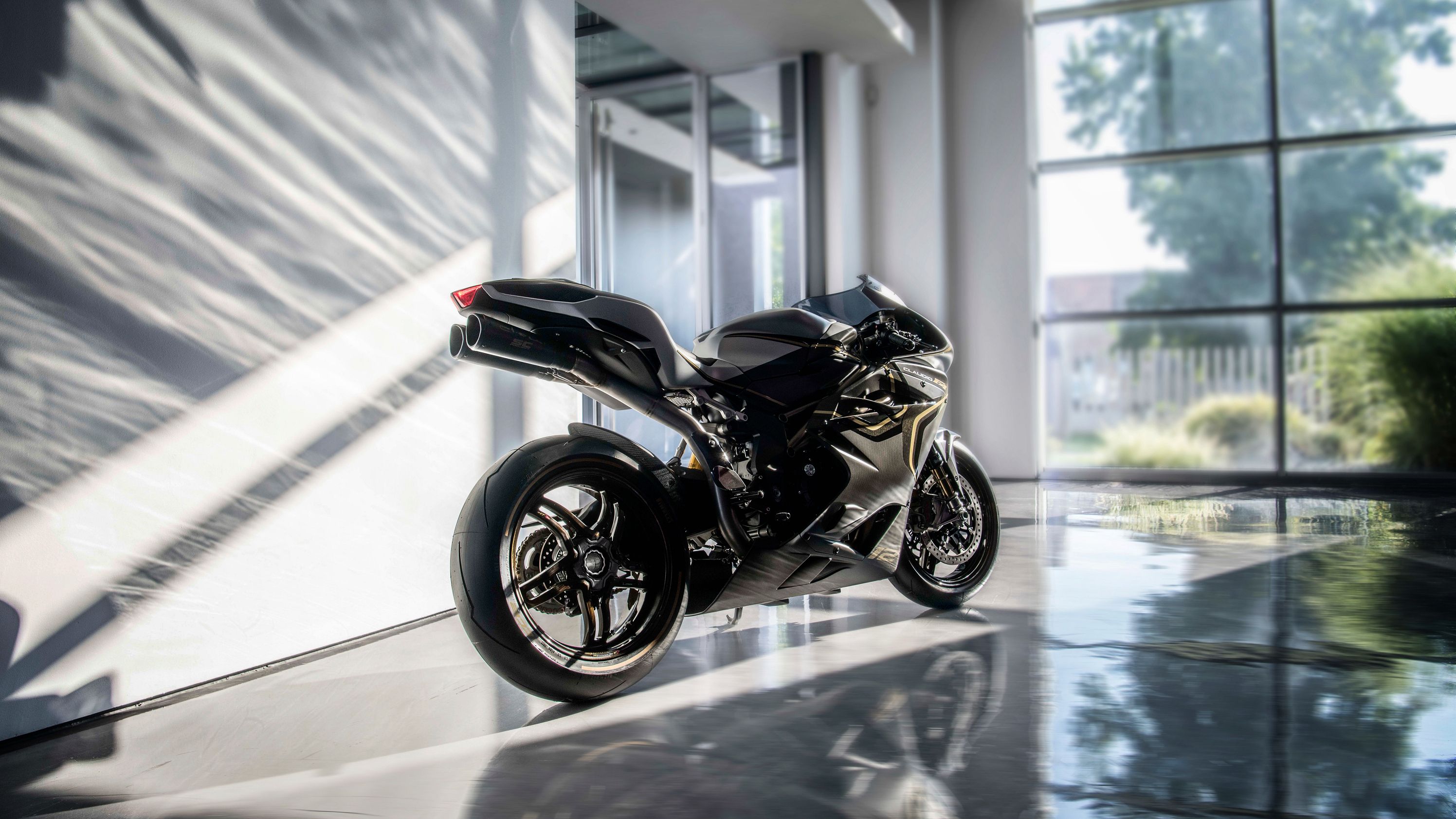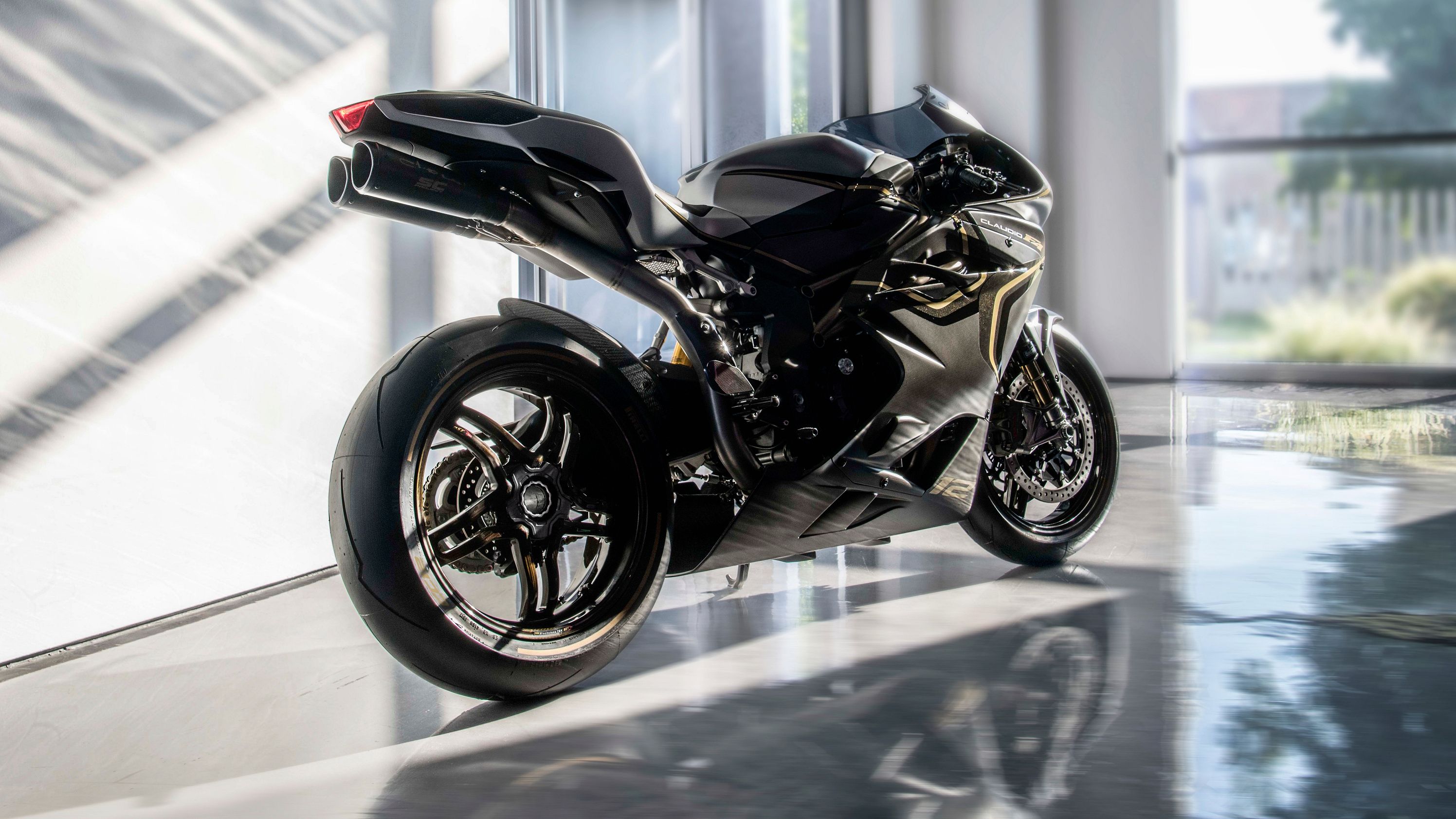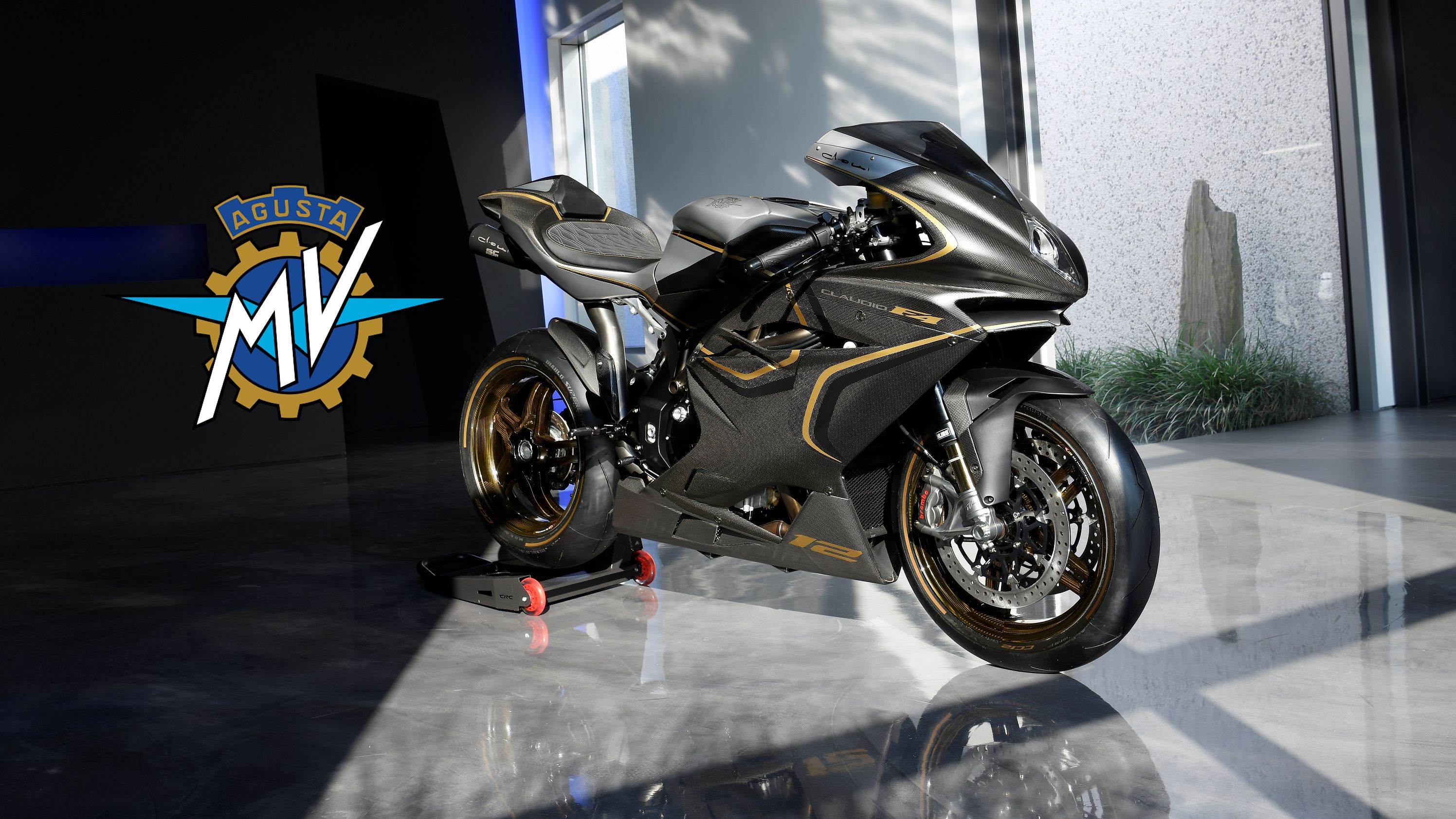Tribute pieces frequently pay homage to a particular year-model or perhaps a certain race, but MV Agusta's F4 “Claudio” is a piece of art that doubles as a mobile shrine to its designer; Claudio Castiglioni. The factory used the F4 as a platform for a whole host of 'luxe aesthetics that brush up the looks; no mean feat for a bike called “the world's best-looking bike” back in '97. This machine is far from all-show/no-go. It comes with track-capable power and the electronics you'll need to keep it all under control. It's truly a spectacular specimen, but don't take my word for it, read on and let me convince you.
Continue reading for my review of the MV Agusta F4 Claudio.
2019 MV Augusta F4 Claudio
- Make: Array
- Model: 2019 MV Augusta F4 Claudio
- Engine/Motor: inline-4
- Horsepower: 205 @ 13450
- Torque: 85 @ 9300
- [do not use] Vehicle Model: Array
2019 MV Agusta F4 Claudio Design
Extensive effort was made to reduce the overall weight of the Claudio, and as a result, it weighs in almost 20-pounds lighter than the F4 RC upon which it is built, with a base weight of 403.45-pounds, dry, and a low 385.8-pound dry weight with the optional race-tastic equipment package. Titanium and light-alloy components save some of the mass, but the carbon-fiber components really did the trick in the end. There's just something about carbon fiber; it adds an aesthetic that goes far beyond the cool clear-resin-over-cloth effect. The impression of cutting-edge technology and top-shelf engineering is inescapable, and that's just in the material alone. Electro-plated copper accents add a bit of bling to break up an otherwise dusky panache with root-beer rims for a subtle break from all the black.
A windtunnel-tested fairing parts the air with low-drag penetration, and it gives the Claudio the unmistakable F4 visage. A single, diamond-shaped headlight within the “Alien Queen” assembly relies on just a small wedge of smoked bubble-screen to steer the wind up over the pilot's head in the tucked-in position.
An angular cowl scoop guides the incoming air over the radiator, then bleeds the waste heat off through a series of vents in the engine shroud for low-drag reintegration with the slipstream. Coverage is nearly complete with cowl panels meeting at the bottom to make the superbike chin fairing and belly-pan that mitigates the undercarriage drag. Clip-on bars pull the rider forward over the long, 4.49-gallon fuel tank into the Superman position, so you can disabuse yourself of the notion that you'll be able to push yourself up into something close to a comfortable upright posture, it ain't gonna' happen.
Nestled inside the fairing is a full-color digital instrument display that handles all of the information traffic and doubles as a sort-of flight recorder complete with GPS to monitor for playback the particulars of your bike's performance; kind of like a boxer might watch a fight tape. A wide flange atop the fuel tank serves as a fairing that leaves a generous knee pocket on each side ahead of the narrow waist that pinches frame, seat and tank where they intersect. This leaves you with plenty of room for English with little bulk to bite into your thighs when you go to put your feet down, though the 32.68-inch tall seat will tax those with shorter inseams a bit.
Is it just me, or does the rear end just make this bike? First, it's supremely clean with a tail fairing and well-designed taillights. There's a hugger over the rear hoop; and in the place where you might expect to find some horrible little mudguard, instead, the dual exhaust pipes ride snugged up under the subframe instead of hanging off one (or both) sides where they add to the overall drag. So, the single-side swingarm leaves the rear wheel wide open on the right side for the ultimate in clean looks from that perspective. Overall, it's safe to say this bike exudes an air of performance and exclusivity that is certain to appeal to some well-established racebike fans.
2019 MV Agusta F4 Claudio Chassis
Chrome-molybdenum steel members make up the Trellis frame, but aluminum alloy is the material of choice for the swingarm and swingarm pivot plates for yet another weight-saving measure. The most impressive use of carbon fiber can be found in the 17-inch rims. That's right sports fans, “funny plastic” wheels round out the rolling chassis, and they come lined with Pirelli's Diablo Supercorsa AP hoops that run with a 120/70 up front and a 200/55 out back. The “ZR” rating ensures that the road rubbers will take whatever you decide to dish out.
MVA keeps the rake angle close to the vest, but the Claudio runs with 3.93-inches of trail with an Öhlins steering damper that'll absorb the brunt of the kickback and help keep the bike stable when you loft that front wheel under hard acceleration. Öhlins also provides the suspension components with a set of inverted, 43 mm, NIX 30-type front forks that deliver variable compression- and rebound-damping values with the extra protection of a top-out spring.
Out back, a twin-tube, piggyback TTX36 floats the rear with the same ride-quality tweaks as the front, and the same 4.72-inches of travel. Brembo Racing discs haul down the front wheel with T-Drive system, 320 mm rotors and four-pot, billet-aluminum, Brembo GP calipers. Another four-piston anchor bites the 210 mm disc out back, and both ends fall under the umbrella of the Bosch 9 Plus ABS that rocks a race mode with rear-wheel lift-up mitigation to prevent endos under hard deceleration. Gotta' say, given its bespoke nature, I'm a little surprised that MVA opted to not go for some sort of electronically-adjusted suspension system, but the Claudio gets the next best thing.
|
Frame: |
CrMo Steel tubular trellis |
|
Rear Swing Arm Pivot Plates Material: |
Aluminum alloy - Adjustable swingarm pivot height |
|
Front Suspension: |
Öhlins USD front fork, NIX 30 type with TIN coating on inner tubes, left compression and right rebound manual adjustment, top out spring |
|
Steering Damper: |
Öhlins manually adjustable |
|
Fork dia./Travel: |
43 mm (1.69 in.)/ 120 mm (4.72 in.) |
|
Rear Suspension/Wheel Travel: |
Öhlins progressive, TTX36 twin tube rear shock absorber with piggyback resevoir, compression and rebound adjusted with anodized aluminum adjustment knobs/120 mm (4.72 in.) |
|
Single Sided Swing Arm Material : |
Aluminum alloy |
|
Front Brake: |
Double floating disc with Ø 320 mm Brembo Racing with T-Drive system (Ø 12.6 in.) diameter, with steel braking disc and aluminum flange Brembo radial pump/level assembly |
|
Front Brake Caliper: |
Brembo GP radial-type, single-piece with 4 pistons Ø 30 mm (Ø 1.18 in.) |
|
Rear Brake: |
Single steel disc with Ø 210mm (Ø 8.27 in.) dia. |
|
Rear Brake Caliper: |
Nissin with 4 pistons - Ø 25.4 mm (Ø 1.00 in.) |
|
ABS System: |
Bosch 9 Plus with Race Mode and RLM (Rear wheel Lift-up Mitigation) |
|
Front Wheel: |
BST Full carbon 3.50 ” x 17 ” |
|
Rear Wheel: |
BST Full carbon 6.00 ” x 17 ” |
|
Front Tire: |
Pirelli Diablo Supercorsa SP (limited edition CC12) 120/70 - ZR 17 M/C (58 W) |
|
Rear Tire: |
Pirelli Diablo Supercorsa SP (limited edition CC12) 200/55 - ZR 17 M/C (78 W) |
2019 MV Agusta F4 Claudio Drivetrain
Naturally, the powerplant is quite the showstopper all by itself. It starts out with an inline, four-cylinder configuration that's water-cooled for thermal stability and runs dual over-head cams to time the 16-valve head. Massively oversquare, the mill has a 79 mm bore and 50.9 mm stroke for a total of 998 cc and a smokin' hot, 13.4-to-1 compression ratio, but you should have already known you'd be feeding this beast only the finest road champagne.
MVA's Motor & Vehicle Integrated Control System manages the push-o-line with two injectors per cylinder; a high-flow Magneti Marelli for the top-end and a Mikuni for the rest of the rev range. The intake is further modified by the “Torque Shift System” that features variable-length intake tracts to deepen the powerband. Don't expect that to diminish its preference for the top-end; you'll have to wind it up to 9,300 rpm to find the full 84 pound-feet of torque, and 205-horsepower at 13,450 for the stock model. (212/13,600 with the racing kit.)
Ride-by-Wire throttle control conveys the rider's demand to the engine control, but they are more like guidelines than actual rules. The signal is (more or less) modified by the four-map Torque Control and eight-level Traction Control to deliver a custom-tailored performance profile. That's right, you can dial in as much -- or as little -- help as you feel like you need, but no matter how you configure it, you've got a tiger by its tail once you climb aboard this thing. You would do well to show it the respect it deserves, 'cause this is a bona fide, street-legal racebike with a claimed top speed of 187.65 mph.
A six-speed transmixxer keeps the revs in the usable power range with a slipper-clutch on backtorque-mitigation duty to prevent loss of traction during aggressive engine-brake maneuvers. A chain-type final drive finishes off the drivetrain.
|
Engine: |
Four cylinder, 4 stroke, 16 valve “D.O.H.C”, radial valve |
|
Displacement: |
998 cc (60.9 cu. in.) |
|
Compression ratio: |
13.4:1 |
|
Starting: |
Electric |
|
Bore x Stroke: |
79 mm x 50.9 mm (3.1 in. x 2.0 in.) |
|
Max. Power (at the crankshaft): |
151.0 kW (205 hp) @ 13,450 rpm |
|
Max. Torque: |
115.0 Nm (84.8 lb-ft) @ 9,300 rpm |
|
Cooling System: |
Cooling with separated liquid and oil radiators |
|
Engine Management System: |
Integrated ignition - injection system MVICS (Motor & Vehicle Integrated Control System) with eight injectors (4 lower fuel injectors by Mikuni + 4 upper fuel injectors by Magneti Marelli with increased fuel flow). Engine control unit Eldor EM2.0, throttle body full ride by wire Mikuni, pencil-coil with ion- sensing technology, control of detonation and misfire - Torque control with four maps, Traction Control with eight levels of intervention with lean angle sensor - TSS Torque Shift System employing variable length intake runners |
|
Electronic Quick-Shift: |
MV EAS 2.0 (Electronically Assisted Shift Up & Down) |
|
Clutch: |
STM Wet, multi-disc with back torque limiting device and Brembo radial pump/lever assembly |
|
Transmission: |
Cassette style; six speed, constant mesh and DLC coated shift forks |
|
Primary drive: |
48/82 |
|
Gear Ratio: |
First gear: 14/37, Second gear: 16/33, Third gear: 18/31, Fourth gear: 20/30, Fifth gear: 22/29, Sixth gear: 21/25 |
|
Final Drive Ratio: |
15/41 |
2019 MV Agusta F4 Claudio Pricing
Looks like you'll be able to get your hands on a Claudio Stateside come June 2019. That's the good news. The bad news is; they're only gonna' make an even hundred of them and MSRP is expected to be somewhere just north of $83,000. I reckon that's actually good news if exclusivity is a big selling point for you.
|
Fairing Material: |
Carbon fiber and thermoplastic |
|
Color: |
Carbon fiber |
|
Price: |
$83,000+ |
2019 MV Agusta F4 Claudio Competitors
How do you pick a competitor for something so unique and limited in nature? I know how to pick my battles, and I think a broadside is appropriate here. If I ignore the limited-edition point and the rolling-tribute angle and just focus on the performance side of things, it leads me first to Honda's street-legal racebike, the RC213V-S. Honda's entry is based on its award-winning MotoGP contender, and while that puts it in a very special niche in the market, the price tag makes it even more exclusive at $184,000.
As far as engine performance goes, the Honda is available across the pond with the full 160-horsepower that falls well short of the 200-plus figures from the Claudio. However, bikes imported to the U.S. will be restricted to a flat 100-ponies, and that, my friends, is its death knell in this contest.
At the other end of the exclusivity (and price) spectrum is the YZF-R1M from Yamaha. The Tuning Fork Company hits the road with 200-ponies and a robust electronics suite, but prices it like a bargain-basement racebike at only $22,999. You could buy three of them and still come out ahead.
He Said
“What a bike! I mean, nothing was spared, or sacred, when MVA set this thing up. From the carbon-fiber bodywork to the electronic fandanglery, the Claudio is easily among the most eligible mid-life crisis machine. Way outta' my league, that's for certain; I can barely afford to even look at the thing.”
She Said
My wife and fellow motorcycle writer, Allyn Hinton, says, “Honestly, if you have to ask how much, you can't afford this bike. The F4 Claudio is the last hurrah for the F4 line since MV Agusta is retiring the superbike with this last tribute to the man that started it all.”
2019 MV Agusta F4 Claudio Specifications
|
Engine & Drivetrain: |
|
|
Engine: |
Four cylinder, 4 stroke, 16 valve “D.O.H.C”, radial valve |
|
Displacement: |
998 cc (60.9 cu. in.) |
|
Compression ratio: |
13.4:1 |
|
Starting: |
Electric |
|
Bore x Stroke: |
79 mm x 50.9 mm (3.1 in. x 2.0 in.) |
|
Max. Power (at the crankshaft): |
151.0 kW (205 hp) @ 13,450 rpm |
|
Max. Torque: |
115.0 Nm (84.8 lb-ft) @ 9,300 rpm |
|
Cooling System: |
Cooling with separated liquid and oil radiators |
|
Engine Management System: |
Integrated ignition - injection system MVICS (Motor & Vehicle Integrated Control System) with eight injectors (4 lower fuel injectors by Mikuni + 4 upper fuel injectors by Magneti Marelli with increased fuel flow). Engine control unit Eldor EM2.0, throttle body full ride by wire Mikuni, pencil-coil with ion- sensing technology, control of detonation and misfire - Torque control with four maps, Traction Control with eight levels of interventionwith lean angle sensor - TSS Torque Shift System employing variable length intake runners |
|
Electronic Quick-Shift: |
MV EAS 2.0 (Electronically Assisted Shift Up & Down) |
|
Clutch: |
STM Wet, multi-disc with back torque limiting device and Brembo radial pump/lever assembly |
|
Transmission: |
Cassette style; six speed, constant mesh and DLC coated shift forks |
|
Primary drive: |
48/82 |
|
Gear Ratio: |
First gear: 14/37, Second gear: 16/33, Third gear: 18/31, Fourth gear: 20/30, Fifth gear: 22/29, Sixth gear: 21/25 |
|
Final Drive Ratio: |
15/41 |
|
Chassis: |
|
|
Frame: |
CrMo Steel tubular trellis |
|
Rear Swing Arm Pivot Plates Material: |
Aluminum alloy - Adjustable swingarm pivot height |
|
Front Suspension: |
Öhlins USD front fork, NIX 30 type with TIN coating on inner tubes, left compression and right rebound manual adjustment, top out spring |
|
Steering Damper: |
Öhlins manually adjustable |
|
Fork dia./Travel: |
43 mm (1.69 in.)/ 120 mm (4.72 in.) |
|
Rear Suspension/Wheel Travel: |
Öhlins progressive, TTX36 twin tube rear shock absorber with piggyback resevoir, compression and rebound adjusted with anodized aluminum adjustment knobs/120 mm (4.72 in.) |
|
Single Sided Swing Arm Material : |
Aluminum alloy |
|
Front Brake: |
Double floating disc with Ø 320 mm Brembo Racing with T-Drive system (Ø 12.6 in.) diameter, with steel braking disc and aluminum flange Brembo radial pump/level assembly |
|
Front Brake Caliper: |
Brembo GP radial-type, single-piece with 4 pistons Ø 30 mm (Ø 1.18 in.) |
|
Rear Brake: |
Single steel disc with Ø 210mm (Ø 8.27 in.) dia. |
|
Rear Brake Caliper: |
Nissin with 4 pistons - Ø 25.4 mm (Ø 1.00 in.) |
|
ABS System: |
Bosch 9 Plus with Race Mode and RLM (Rear wheel Lift-up Mitigation) |
|
Front Wheel: |
BST Full carbon 3.50 ” x 17 ” |
|
Rear Wheel: |
BST Full carbon 6.00 ” x 17 ” |
|
Front Tire: |
Pirelli Diablo Supercorsa SP (limited edition CC12) 120/70 - ZR 17 M/C (58 W) |
|
Rear Tire: |
Pirelli Diablo Supercorsa SP (limited edition CC12) 200/55 - ZR 17 M/C (78 W) |
|
Details: |
|
|
Fairing Material: |
Carbon fiber and thermoplastic |
|
Color: |
Carbon fiber |
|
Price: |
$83,000+ |
Further Reading
Honda RC213V
See our review of the Honda RC213V.
Yamaha YZF-R1M
See our review of the Yamaha YZF-R1M.
Read more MV Agusta news.

